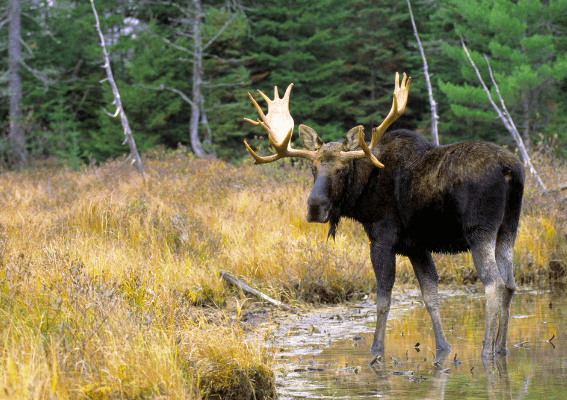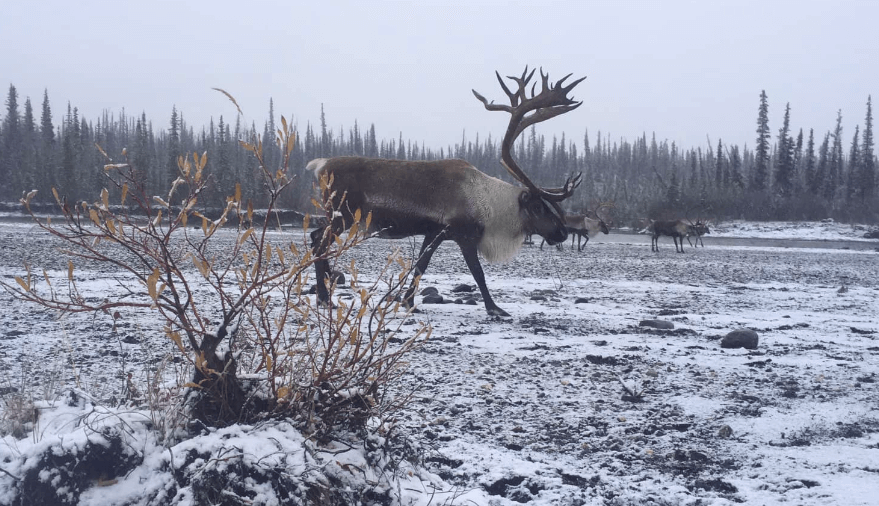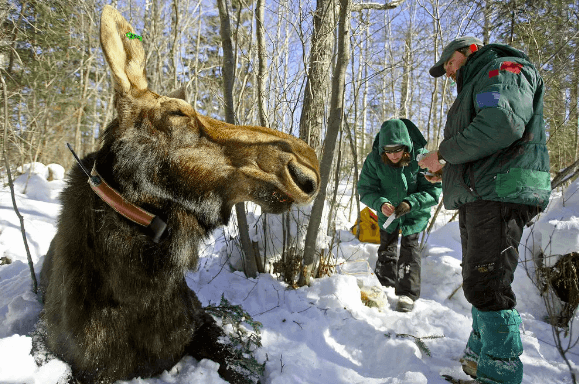What can you hunt in Alaska?
Hunting in Alaska is an exciting and one-of-a-kind experience that draws sportsmen from all over the world. Alaska provides exceptional possibilities for both resident and non-resident hunters to chase a variety of game species due to its vast wilderness, numerous animals, and challenging environments. Whether you want to stalk a beautiful moose, track elusive caribou over wide tundra, or put your abilities to the test against fearsome brown bears, Alaska’s untamed environment offers a hunting journey unlike any other. Glowing Splint has the Best Selection of hunting e-bikes to make your adventure more fun.
Alaska provides a diversified range of hunting chances because of its vast and diverse wilderness. Here’s a rundown of some of the famous species that may be hunted in Alaska:
Moose:

Alaska is well-known for its enormous moose population, and moose hunting is a popular pastime. Moose hunts are usually held in September, during the rutting season, when bulls are more active and noisy. Moose supply a substantial amount of meat, making them a popular large game animal.
Caribou:

Caribou hunting in Alaska is an exciting activity. There are various subspecies of caribou, including barren-ground caribou, mountain caribou, and woodland caribou. Caribou hunts frequently utilize spot-and-stalk methods, and caribou herd migratory patterns can present exciting possibilities for successful hunts.
Dall Sheep:

Dall Sheep, an iconic animal recognized for its magnificent white coat and formidable horns, are found in Alaska. Dall Sheep hunting is a very tough sport since they live in steep and rough alpine terrain. It demands stamina, endurance, and pinpoint accuracy. Dall Sheep hunting is strictly restricted, and acquiring a permission can be difficult.
The Black Bear:

Alaska has a strong black bear population, and hunting them may be an exhilarating experience. Black bear hunting is usually done in the spring and fall. Spot-and-stalk, baiting, and calling are all tactics of hunting. The quantity of black bears in Alaska affords numerous hunting chances.
The Brown Bear:

The coastal brown bears, often known as grizzly bears, are famous in Alaska. Brown bear hunts are highly controlled and need the use of a guide or an experienced hunter to guarantee safety and adherence to hunting laws. These hunts need meticulous preparation, understanding of bear habits, and weapons ability.
Sitka Black-tailed Deer:

The Sitka black-tailed deer is mostly found in Alaska’s coastal rainforest zones. Hunting them provides a unique blend of scenic beauty and difficult terrain. Sitka black-tailed deer hunts often take place in late summer and fall, using tactics such as spot-and-stalk and still hunting.
Small Game:

Small game animals such as ptarmigan (grouse), snowshoe hare, waterfowl (ducks, geese), and upland birds can also be hunted in Alaska. These hunts provide a variety of difficulties and can be used to supplement larger game hunts or as stand-alone hunting trips.
It’s crucial to note that hunting restrictions, bag limits, and seasons vary by species and area in Alaska. It is essential to investigate and become acquainted with the individual hunting legislation and requirements of the location in which you wish to hunt. Hiring an experienced guide or outfitter may also improve your hunting experience and assure compliance with local restrictions, as well as provide vital expertise and support in traversing Alaska’s wilderness.
Can tourists hunt in Alaska?
Tourists can hunt in Alaska, but they must adhere to certain rules and restrictions. Consider the following crucial points:
Non-Resident Hunting Permit:
To hunt in Alaska, non-residents must get a hunting license. The hunting license is valid for a set length of time and permits the holder to engage in hunting activities.
Species-Specific Permits and Tags:
Additional tags and permits may be necessary depending on the species you wish to hunt. These species-specific tags and permits are frequently in short supply and may need applying through a lottery or drawing mechanism.
Registered Guide or Non-Guided Hunt:
Non-residents hunting certain species, such as brown bear, muskox, and Dall Sheep, are required to be accompanied by a registered guide or hunt under the guidance of a close relative who is an Alaska resident. Non-guided hunts, where a registered guide is not necessary, are available for other species such as moose, caribou, and black bear.
Hunter Education:
Non-residents born after January 1, 1986, must possess a valid hunter education certificate or its equivalent from their home state or province. This requirement ensures that hunters have the necessary knowledge and safety skills.
Compliance with Regulations:
Non-resident hunters must comply with all hunting regulations set by the Alaska Department of Fish and Game. These regulations include bag limits, specific hunting seasons, and any restrictions on methods and equipment.
It is essential for tourists to thoroughly research and familiarize themselves with Alaska’s hunting regulations, as they can vary depending on the specific region, species, and hunting method. Additionally, hiring an experienced outfitter or guide can greatly enhance the hunting experience for tourists by providing local knowledge, assistance with logistics, and ensuring compliance with all legal requirements
Transportation and lodging:
Tourists must plan transportation to and from Alaska, as well as lodging during their hunting excursion. This might include organizing flights, finding housing, and arranging transportation to hunting grounds.
Tourists must properly investigate and get acquainted with Alaska’s hunting restrictions, which might vary according on the location, species, and hunting style. Hiring an experienced outfitter or guide may also substantially improve the hunting experience for visitors by offering local expertise, aid with logistics, and assuring compliance with all legal requirements.

Can you survive in Alaska by hunting?
Yes, for many Alaskans, hunting to subsist is a traditional and practical way of life, particularly in more distant and rural places. Hunting is an important source of food for sustenance because of the wide wilderness, restricted access to shops, and the expensive cost of imported commodities. Here are some important considerations to remember when hunting for survival in Alaska:
Subsistence Living:
Many Alaskans, particularly those in remote areas, rely on hunting for a living. Traditional subsistence hunting techniques are strongly ingrained in indigenous and rural communities’ cultures and histories, where hunting supplies not just food but also essential cultural and social relationships.
Food Security:
Because of Alaska’s isolated locations and severe environment, transporting and supplying food is difficult and expensive. Residents may acquire a locally accessible and sustainable food supply through hunting, contributing to food security and lowering dependency on imported items.
Traditional Practices:
Survival hunting is frequently guided by traditional knowledge and methods passed down through generations. It necessitates a thorough knowledge of the area, seasons, and animal behavior, as well as the use of sustainable hunting tactics to ensure the long-term viability of wildlife populations.
Legal and Regulatory Framework:
While hunting for subsistence purposes is allowed and regulated, it is important to adhere to hunting regulations, bag limits, seasons, and any specific restrictions or permits related to certain species. These regulations are in place to ensure the conservation of wildlife populations and sustainable hunting practices.
Cultural Importance:
Hunting for survival in Alaska goes beyond mere sustenance; it plays a significant role in cultural identity, community cohesion, and the passing down of traditional knowledge. It fosters a deep connection with the land, wildlife, and the cycles of nature.
While hunting for survival is a way of life for many Alaskans, non-residents and visitors must follow various rules and may have distinct hunting rights. If you want to hunt for survival in Alaska, you must first learn and respect the cultural and legal components of subsistence hunting, as well as get the proper permits and licenses.
What is Alaska’s most hunted big game species?

The moose is Alaska’s most hunted big game animal. Because of the richness of moose populations and the enormous amount of meat they supply, moose hunting is extremely popular among both local and non-resident hunters. Caribou hunting is another popular pursuit in Alaska. The state is home to several caribou subspecies, including the barren-ground caribou, mountain caribou, and woodland caribou. The migratory herds and vast landscapes of Alaska offer exciting opportunities for caribou hunts. Here are some of the reasons why moose hunting is so popular in Alaska:
Abundance:
Moose are abundant in Alaska, making them one of the most accessible big game animals for hunters. The immense wildness and different ecosystems of the state give several possibilities to see moose.
Trophy Possibility:
Alaska is well-known for producing trophy-size moose with huge antlers. Many hunters are lured to the challenge and pleasure of hunting these beautiful creatures and the possibility of harvesting a trophy-sized bull.
Subsistence Hunting:
Moose meat is prized for its exceptional quality and quantity. Moose hunting is a major source of food for many households in Alaska, where subsistence hunting is important in local communities.
Exciting Hunts:
Spot-and-stalk techniques, calling, and strategic hunting strategies are frequently used while hunting moose. When bulls are more active and noisy during the rutting season in September, it provides excitement and potential for successful hunts.
Yield of Meat:
Moose are the biggest deer family members and supply a considerable amount of meat, making them an appealing target for hunters eager to stock their freezers with high-quality, lean protein.
Hunting Tradition:
In Alaska, moose hunting has cultural and historical value. It is profoundly ingrained in the fabric of many communities, and moose hunting traditions have been passed down through generations.
It’s crucial to remember that the popularity of large game species varies depending on personal tastes, hunting area, and accessible hunting chances. Other large game animals, such as caribou, black bear, and Dall sheep, are also popular for hunting in Alaska.
Similar post






